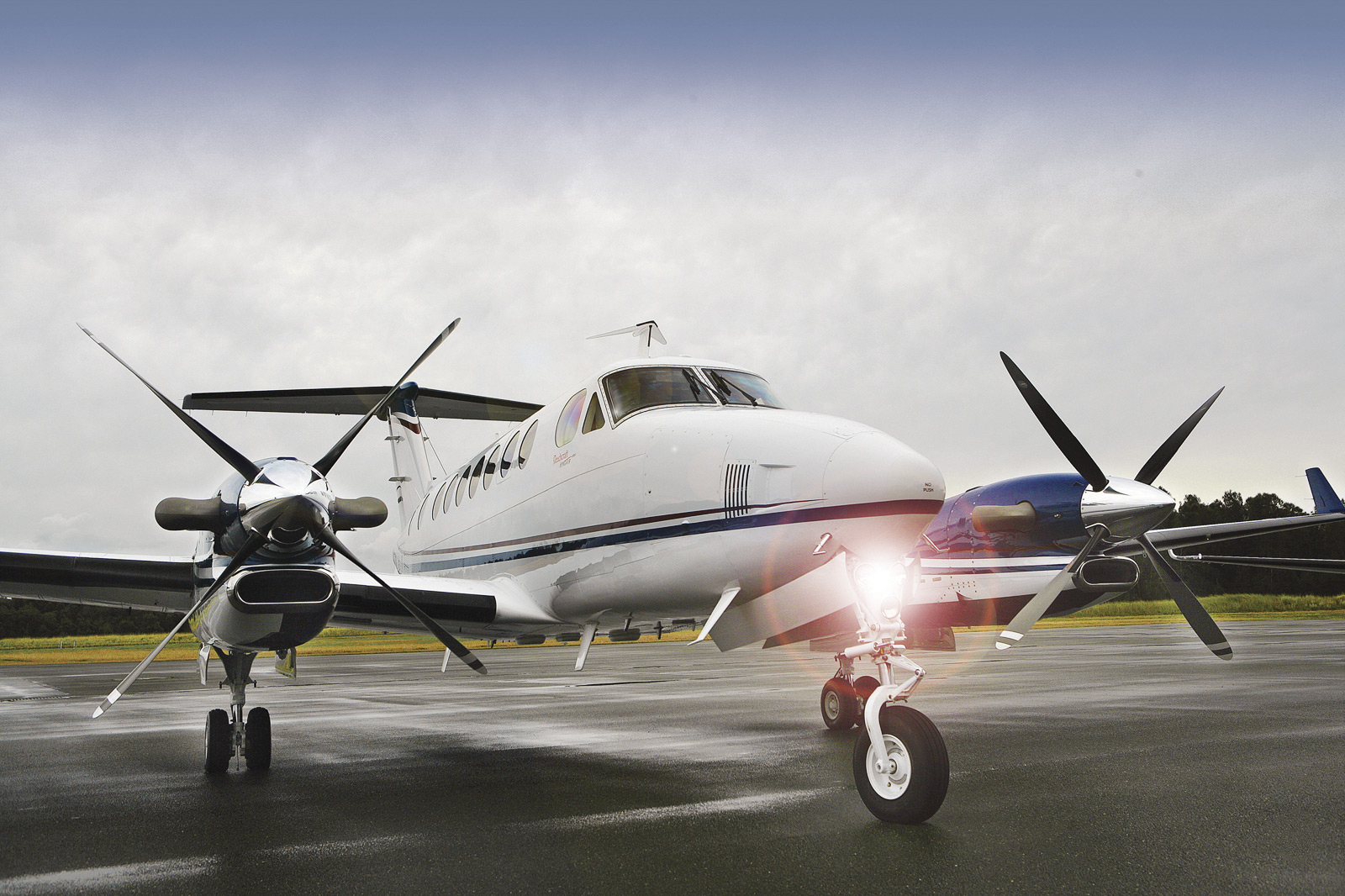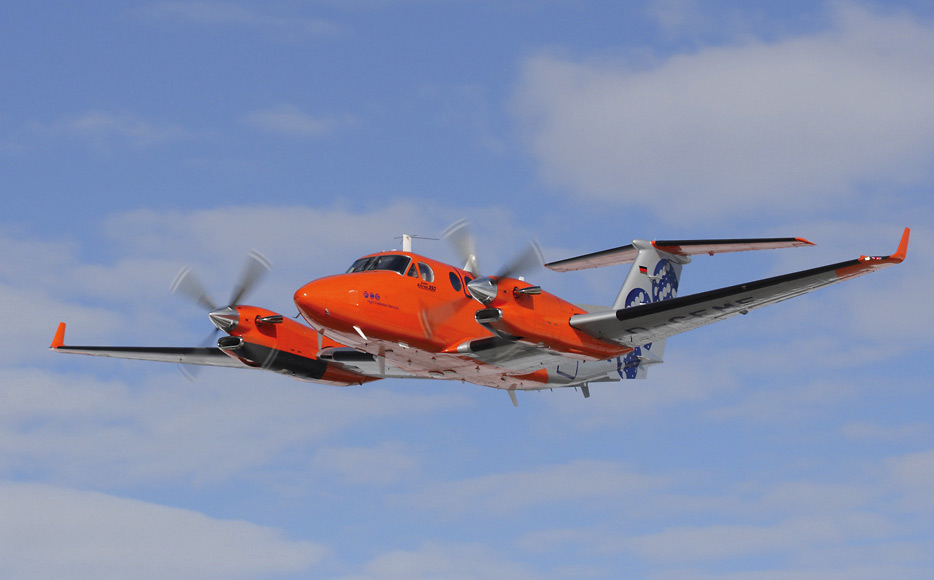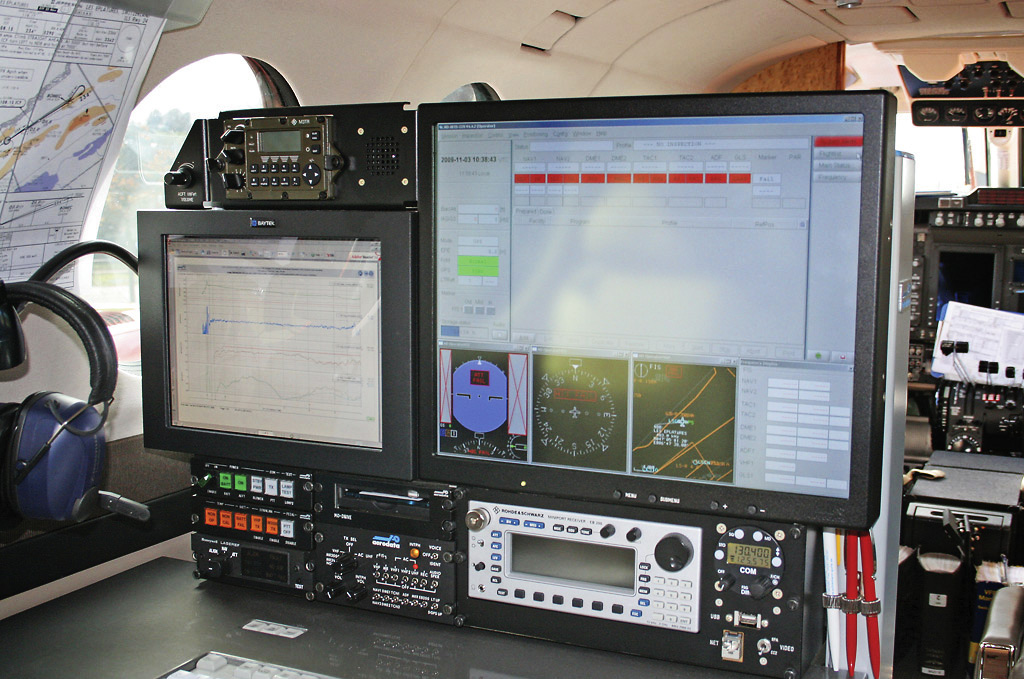Back to Flight Inspection
Aircraft for flight inspection in Europe

Helping airports meet safety regulations
Around the world, pilots rely on a myriad of communications, navigation and surveillance systems to fly safely. To ensure operational readiness, companies like FCS Flight Calibration Services GmbH of Germany routinely measure and calibrate the airways using turboprop aircraft equipped with sophisticated flight inspection technology. The combination provides a nimble, reliable, cost-effective platform for certifying airport navigational aids to incredibly precise tolerances.
In 1993, when Germany switched from heavy, expensive aircraft to lean turboprops, the country improved the efficiency of its flight inspection services while significantly reducing costs. More than 20 years later, the Beechcraft® King Air® 350 is still the aircraft of choice.
At Baden-Baden Airport in Germany, a twin turboprop flies another approach, its fifth of the morning, at the busy international airport. The flight inspection crew is testing the instrument landing system, specifically checking the frequencies that show pilots whether they’re on course. Over the next four hours, the crew will circle the airport, monitoring, measuring and calibrating the navigational aids used by hundreds of pilots every day.
Based in Braunschweig, a small, historic city in northern Germany, FCS Flight Calibration Services GmbH uses two identically-configured Beechcraft King Air 350 aircraft for its flight inspection and flight validation services. The company is a joint venture of DFS Deutsche Flugsicherung GmbH and two other European air navigation service providers created after Germany privatized its air navigation services in 1993. Today it flies each of its aircraft nearly 1,000 hours a year, inspecting navigation systems in Germany, Switzerland and Austria.
“Our company, previously known as Flight Inspection International, bought its first King Air 350s back in 1993, replacing the HS748s that had been used for flight inspection in Germany until then. After a service life of more than 12 years, it was a natural decision to go for King Airs again when replacing the first aircraft,” Rüdiger Schmidt, managing director of FCS Flight Calibration Services GmbH, said.
“We have a couple of airports with short runways and steep approaches in Switzerland. These are the main reasons we opted for the King Air 350,” Mathias Steenbuck, director flight of operations for FCS Flight Calibration Services GmbH, said.

Enabling precision evaluations, the company’s flight inspection aircraft are outfitted with high-tech capabilities and equipment, such as autopilot coupling and calibrated 3D antennas necessary for measuring field strength within stringent International Civil Aviation Organization (ICAO) tolerance limits.
Each King Air is equipped with leading avionics, including a Rockwell Collins Pro Line 21 Integrated Avionics System, FMS-3000 Flight Management System and ADS-B solution as well as Honeywell’s EGPWS Enhanced Ground Proximity Warning System.
“The main equipment we rely on is the flight inspection system (FIS) supplied by Aerodata, who also handled the system’s integration. The FIS is responsible for measuring and recording all parameters of interest. It also provides its own positioning solution, using differential phase GPS augmentation for ILS and APV SBAS calibrations where we need the highest precision,” Markus Schwendener, director Continuing Airworthiness Management Organization for FCS Flight Calibration Services GmbH, said.
Aerodata’s flight inspection systems are in operation in more than 60 countries around the world. The modular architecture and open system software provide the flexibility to add future expansions, if needed. The AeroFIS Automatic Flight Inspection System onboard uses a Windows-based interface that can be operated by one crewmember. For operators who use their aircraft for other missions, mobile AeroFIS configurations can be removed from the aircraft in less than an hour.

The central component of Aerodata’s AeroFIS Automatic Flight Inspection System is a complex hybrid positioning system that combines several sensors. Its data is accurate to a few centimeters.
“Modifications to the airframe mainly comprised of installing the flight inspection system with all its interfaces and mounting the large number of flight inspection antennas we needed. In the avionics compartment, we wanted to make sure all of the systems stay as up-to-date as possible, so we installed the WAAS/RNP upgrades as soon as they were available to us,” Schwendener said.
Flight inspection missions in Germany typically take a week to complete. In Austria, it’s two weeks. The company bases the aircraft in Vienna and shuttles the crew back to Germany, if necessary.
“Typical parameters we check are DDM for ILS, bearing errors for DVOR and, of course, coverage and field strength. We calibrate a number of airport sites by night to avoid interfering too much with the heavy metal traffic. As part of our safety management system, we adopted new fatigue management guidelines for night work, an important issue,” Steenbuck said.
Typical ICAO standards
- ILS inspections every 180 days
- VOR/DME and NDB calibrations annually
- Flight validation of GPS RNAV/RNP procedures prior to first publication or for changes
- GBAS (LAAS) and APV SBAS (WAAS) commissioning and annual checks
The biggest challenge for FCS Flight Calibration Services GmbH has come over the last couple of years while adapting to new processes for flight validation of GPS-required navigation performance procedures (RNP); ground-based
augmentation systems (GBAS); and Approach Procedures with Vertical Guidance (APV) Satellite-Based Augmentation Systems (SBAS).
“This is a pretty complex issue, as handling avionics and flight inspection equipment upgrades, juggling databases, qualifying staff, and keeping the ‘QM OK’ stamp on it all, including certification, all need to go hand in hand. But, we started early in Germany with procedure validation more than 10 years ago. The new ICAO 9906/Vol. 5 document did not come as a big surprise to us,” Schmidt said.
“GBAS and APV SBAS checks are now more or less routine for us. The King Air 350 aircraft certainly helped with that because we had the upgrades and technical support we needed. Overall, we are very pleased with the performance and reliability of our King Airs.”
To view all of our special missions aircraft visit
http://specialmissions.txtav.com